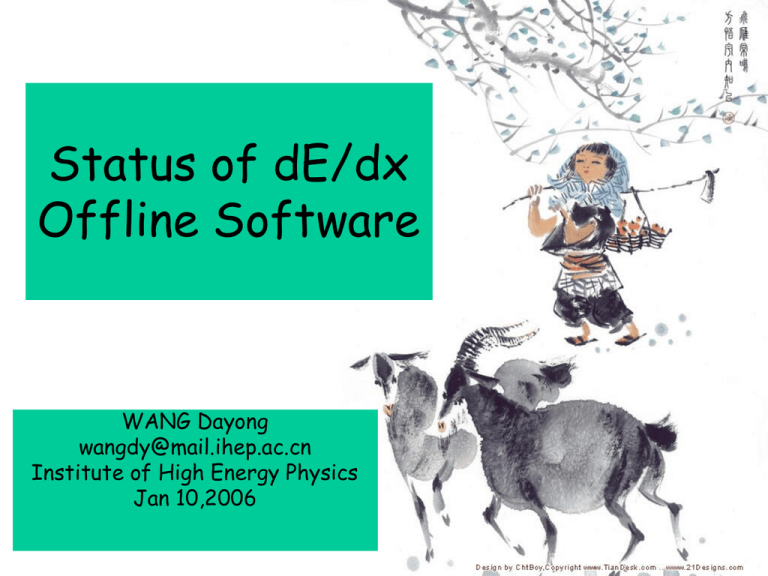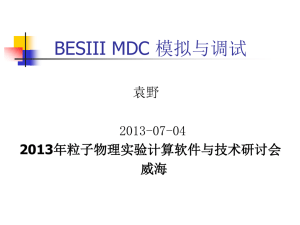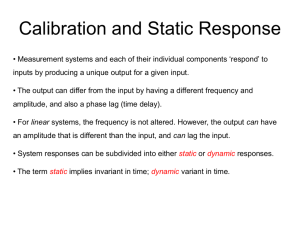dE/dx calibration and reconstruction
advertisement

Status of dE/dx Offline Software WANG Dayong wangdy@mail.ihep.ac.cn Institute of High Energy Physics Jan 10,2006 Outline dE/dx software :OO design and development MdcDedxAlg : Reconstruction DedxCalibAlg : Calibration DedxCorrecSvc : Public service for dE/dx correction Calibration and systematic corrections Important systematic and enviromental effects Calibration parameteriazation Reconstruction algorithm studies: Different estimation of most prob Eloss Ionization Curve studies Resolution and residual bias correction Summary dE/dx :Particle ID with energy loss measurements Principle: MDC trackin g dE/dx~f(v) Particle type info P = · m Implementation: C++ programming under BOSS framework Components: MdcDedxAlg, DedxCalibAlg, DedxCorrecSvc Design goal: Resolution 6—7%, good seperation Requirements and data flow MDC digits AIM: to give the partID information from the list of pulse heights of hits on the MDC track, and store them into TDS some corrections are performed to get unbiased dE/dx information. Some proper dE/dx estimators are constructed MDC digits MDC Tracking Tracks Transient Data Store (TDS) MDC digits Tracks Recon dE/dx Tracks dE/dx Reconstruction Recon dE/dx Recon dE/dx Global Particle partId info Identification 。。。 Apparent dataflow Real dataflow physics analysis Overview of the software converter Transient Data Store DST <<uses>> <<uses>> EventDataSvc MdcDedxRecon DedxCalibAlg <<uses>> <<uses>> DedxCorrecSvc <<uses>> <<uses>> <<uses>> CalibDataSvc Transient Calib Data Store Calibration const converter MdcGeomSvc dE/dx calibration package Algorithm DedxCalibAlg DedxCalib +initialise() +execute() +finalise() +BookHists() +FillHists() +AnalyseHists() +WriteHists() +getChargeOffCorr() +ReadParameters() +WriteParameters() DedxCalibWireGain DedxCalibLayerGain DedxCalibDriftDist <<uses>> DedxCalibParameters DedxCalibSaturation DedxCalibZpos DedxCalibRunByRun DedxCorrecSvc IInterface +queryInterface() IService IProperty +name() +initialize() +finalize() +setProperty() +getProperty() Service IDedxCorrecSvc +StandardCorrec() MdcGeomSvc <<uses>> <<uses>> CalibSvc DedxCorrecSvc -m_run -m_calib_flag -m_calib_const +StandardCorrec() +WireGainCorrec() +DriftDistCorrec() +SaturCorrec() +ZdepCorrec() +LayerGainCorrec() +GlobalCorrec() +PathL() Calibration data structure double m_wireg[6860]; double m_ggs[4][43]; double m_ddg[4][43]; double m_zdep[4][43]; double m_layerg[43]; double m_gain; double m_resol; Sys. effects and dE/dx corrections ① ② ③ ④ ⑤ ⑥ ⑦ ⑧ Gain variations among cells Sampling length corrections Drift distance dependence Longitude position(z) dependence Space charge effect Charge gain non-linearity: from electronics Corrections related to particle type Run by run pulse height correction:Dependence on the sense wire voltage ,temperature, pressure and other environmental effects… Parameterizations in calibration Gas gain: Standard Landau distribution Vavilov distribution Asymmetric Gaussian distribution: Space charge effect: general form of Q’=Q/(1-k(θ)*Q) BesII: fit with polynomial:a=F(40°)/F(θ) Q’=Q*a Q CLEOII formulation: ( ) ' cos Q Q δ:longitude range of avalanche Q 1 ( ) Babar formulation: cos Parameterization of other effects: These parameterizations are to be tested by long-model data analysis 3 order polynomials (presently implemented) Chebyshev series with the 1st kind of Chebyshev polynomials Comparison and choice of dE/dx curve Sternheimer(A) is better Comparison of Sternheimer and Va’vra formula: A at high momentum end Va’vra(B) is relative better at low momentum end Practical global parameterization of curve is prefered B BESIII Simulation Preliminary Landau formula X P2~0 4-par fit X Global 5-parameter fit for phmp_nml vs p5 dE p1 1 p4 p 4 p 2 ln p3 dx binning with nearly the same statisticsat each point to reduce the error Beam-gas proton Using garbage events in order to fastly calibrate this curve for BESIII in future Cosmic rays BESII data Radiative bb A uniform formula to avoid discrete expression for density effect The curve fit the BESII data OK The best dE/dx curve obtained BESIII Simulation Preliminary p5 dE p1 1 p4 p 4 p 2 ln p3 dx 1. In whole BesIII momentum range: 0.15—2GeV/c, good uniformity is seen with different particles and with momentum overlap; 2. Quality of curve fitting is good in the whole range 3. The fitting results is quite stable Algorithm studies: different estimation of most probable energy loss Landau distribution has no definite mean. The algorithm used must estimate the most probable energy loss Truncated mean Double truncated mean: truncate at both ends idea:these methods Median give less bias to large Geometric mean values,then the satured hits have less Harmonic mean effect to give better shape and better Transformation: seperation Logorithm truncated mean: studies based on BESII data Different estimation of most probable energy loss: resolution 5.51% 5.34% 6.06% 5.09% BOOST MC, MIP muon 5.75% 5.71% Truncation rate: 0.7 5.44% 2.61% Different estimation of most probable energy loss: seperation power Pi/K Pi/P 0.7GeV 1.2GeV Pi/K Pi/P 0.6GeV 1.1GeV Pi/K Pi/P 0.7GeV 1.2GeV Pi/K Pi/P 0.75GeV 1.3GeV BOOST MC, MIP muon Pi/K Pi/P Pi/K Pi/P 0.7GeV 1.3GeV 0.7GeV 1.2GeV Pi/K Pi/P 0.7GeV 1.3GeV Pi/K Pi/P 0.75GeV 1.3GeV Comparison of linear&logorithm TM Logorithm TM(right figure),compared to plain TM(left figure): Suppress high-end residual Landau tail The distribution more Gaussian like shape is more Gaussian-like Pull width: 1.020 Cosmic rays 0.9995 BESII DATA, J/Psi hadrons shape is more Gaussian-like Pull width: 0.8477 Radiative Bhabha 0.9304 Study of truncated mean method Well established method of dE/dx estimation Simple and robust Rejection of lower end hits to remove contributions from noise and background fluctuation Truncation of higher tail to remove Landau tail due to hard collisions Just cooresponding to ~5% lower cut Landau tail After truncation, distribution just Gaussian-like BOOST MC, 1GeV electrons Resolution curve with different truncation rates 70% truncation ratio is adopted for the algorthm Number of good hits is required to no less than 10 for each track Resolution from perfect MC consistent with empirical formula BOOST MC, 1GeV electrons Calibration of σdE/dx Q dependence of σdE/dx σ /Q= p0+p1*ln(Q) , p0,p1 is fitting parameters Hits number and polar angle dependence Empirical formula : 81.0n 0.46 I n 2.35 0.32 n -0.46 , sin 0.32 0.153 Z 1 t 2 A σdE/dx~ polar angle relationship norm p1sin p0 σ ~ hits number relationship dE/dx norm p1Nhit p0 Present performance(I) 5.96% Software are robust Basic calibration and correction,and need more dE/dx resolution can reach design requirements: 6-7% Present performance(II) χ distribution for Kaon sample Distribution of (dE / dxmea dEdxexp ) dE / dx Prob(K)distribution for Kaon sample is nearly a normal N(0,1)distribution Distributions of probability function are flat Our estimation is unbiased and can provide good partId info Present performance(III) dE/dx seperation for 5 particles(MC) seperation power with dE/dx Good particle seperation in a wide range for different particles The important π/K seperation(3 σ )can reach nearly 800MeV/c Particle identification efficiency is more than 90% with MC samples summary OO designed dE/dx software is developed under BOSS, released and used for physics Calibration algorithms and service are developed and many corrections performed to get unbiased estimation of dE/dx Different reconstruction algorithms are explored to get best performance Particle id is tested with MC samples, dE/dx resolution, distributions, pid efficiency is satisfactory. To reach BESIII design goals, there are still much to understand and deal with Thank you 谢谢! Backed -up slides…



